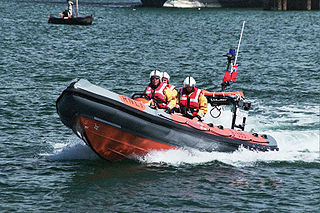
A rigid inflatable boat (RIB), also rigid-hull inflatable boat or rigid-hulled inflatable boat (RHIB), is a lightweight but high-performance and high-capacity unsinkable boat constructed with a rigid hull bottom joined to side-forming air tubes that are inflated with air to a high pressure so as to give the sides resilient rigidity along the boat's topsides. The design is stable, light, fast and seaworthy. The inflated collar acts as a life jacket, ensuring that the vessel retains its buoyancy, even if the boat is taking on water. The RIB is an evolutionary development of the inflatable boat with a rubberized fabric bottom that is stiffened with flat boards within the collar to form the deck or floor of the boat.
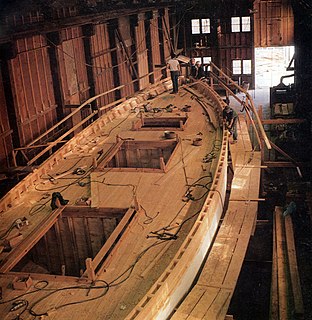
Boat building is the design and construction of boats and their systems. This includes at a minimum a hull, with propulsion, mechanical, navigation, safety and other systems as a craft requires.

A merchant ship, merchant vessel, trading vessel, or merchantman is a watercraft that transports cargo or carries passengers for hire. This is in contrast to pleasure craft, which are used for personal recreation, and naval ships, which are used for military purposes.
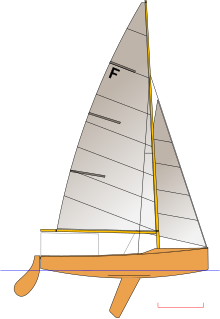
The Firefly is a two-sail, one design, wooden or GRP sailing dinghy with no spinnaker, designed by Uffa Fox in 1946. The first four boats from the production line were named Fe, Fi, Fo and Fum. Number one, Fe, is now owned by the National Maritime Museum Cornwall. Although designed as a double-hander, it was selected as the single handed class for the 1948 Olympics but was subsequently replaced by the Finn class. The class then became popular as a low cost, one design, double hander, as was originally intended, tolerating remarkably well combined weights of 16 to 25 stone.

Sharpies are a type of hard chined sailboat with a flat bottom, extremely shallow draft, centreboards and straight, flaring sides. They are believed to have originated in the New Haven, Connecticut region of Long Island Sound, United States. They were traditional fishing boats used for oystering, and later appeared in other areas. With centerboards and shallow balanced rudders they are well suited to sailing in shallow tidal waters.
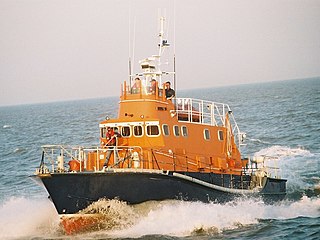
The Arun-class lifeboat was a fast all-weather lifeboat designed by the Royal National Lifeboat Institution (RNLI) for service at its stations around the coasts of the United Kingdom and Ireland. They were operated by the RNLI between 1971 and 2008. Many have been sold to see further service in the lifeboat and coastguard services of other countries.

The 18 ft Skiff is considered the fastest class of sailing skiffs. The class has a long history beginning with races on Sydney Harbour, Australia in 1892 and later in New Zealand. The boat has changed significantly since the early days, bringing in new technology as it became available. Because of the need of strength, agility and skill, the class is considered to be the top level of small boat sailing. Worldwide this boat is called the "18 Foot Skiff". It is the fastest conventional non-foiling monohull on the yardstick rating, with a score of 675, coming only third after the Tornado and Inter 20.

The Westsail 32 was a production fiberglass sailboat built between the years of 1971 and 1980. Approximately 830 were built, about half of them in kit form. The "W32", as they are often referred to, was very heavily built and has taken many people on trouble-free voyages and several circumnavigations. Often thought of as a slow boat, the long waterline and incredible load carrying capabilities of this vessel make it an excellent cruising boat. The Westsail was directly derived from the earlier Kendall 32, of which only a few were made.

The Zephyr is a New Zealand one-design 3.35-metre (11.0 ft) sailing dinghy. Zephyrs are a national class, administered by the Zephyr Owners' Association. Hull form and sail plans are restricted, to ensure all boats have the same potential speed.

The Adventuress sailing dinghy class was designed by Ian Proctor and built by Anglo Marine of Essex. It is no longer in production.

The word Drascombe is a trademark that was first registered by John Watkinson who applied it to a series of sailing boats which he designed and built in the period 1965–79 and sold in the United Kingdom (UK). They comprised the Coaster, Cruiser Longboat, Dabber, Drifter, Driver, Gig, Launch, Longboat, Lugger, Peterboat, Scaffie, Scaith and Skiff, together with a few other one-offs. They have wide and deep cockpits, adaptable boomless rigs and high bulwarks.

The Beachcomber 6.5 is a semi-round bilge glass-reinforced plastic (GRP) trailerable keelboat designed and built in New Zealand 1970 to 1980 by Hart Brothers Marine.
Fairey Marine Ltd, latterly known as FBM Marine, was a boat building company based on the River Hamble, Southampton, England. The company was created in the late 1940s by Sir Charles Richard Fairey and Fairey Aviation's managing director, Mr. Chichester-Smith. Both were avid sailing enthusiasts along with Chichester-Smith's good friend and former Olympic yachtsman, Charles Currey.

The Hornet dinghy is a 16-foot-high performance dinghy designed by Jack Holt in 1952.
The E-Boat, was designed by Julian Everitt, and went into production in 1976 and there are in excess of 250 E-Boats built between 1976 and 1984 of which around one hundred and fifty were in the UK. She was designed to comply with IOR rules and is basically a 22 feet, four berth trailer sailer. The E-Boat Offshore One Design is a light displacement flush deck IOR Mini Ton keel-boat with a lifting cast iron keel, designed in 1974. Most boats sailing are in Great Britain, Ireland, The Netherlands and Denmark.

The Gull sailing dinghy was designed by Ian Proctor in 1956, originally as a frameless double-chine plywood boat. However, it has been through several incarnations: the wooden Mark I, GRP Mark III, GRP Gull Spirit and GRP Gull Calypso. Today it is popular with sailing schools, especially in the United Kingdom.

The Brede-class lifeboat was operated by the Royal National Lifeboat Institution (RNLI) from its stations around the coasts of the United Kingdom between 1982 and 2002, at which time it was the fastest all-weather lifeboat in its fleet. Eleven were put into service and when replaced by larger boats seven were sold for further use as lifeboats, mainly in South Africa.
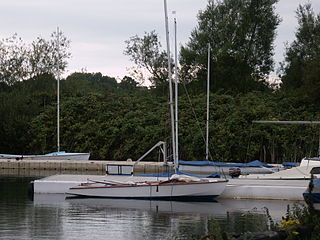
The Skua Sailing Dinghy is a keel assisted two-person racing sailboat, broadly similar to the Flying Fifteen in layout and planned use. It was however designed for simple and inexpensive home construction from 6mm Marine plywood.

The Minisail is a 13-foot single-handed dinghy which was designed by Ian Proctor in 1959 and became popular in the 1960s. It was the predecessor to the Topper and was the first British production boat to popularise the idea of the "sailing surfboard". As the Topper gained popularity in the 1980s, the Minisail disappeared from the scene. However, on 28 August 2011, a group of enthusiasts restarted the Minisail Class Association, which now has a small but committed following mainly in north-west Europe.

Janggolan refers to two different type of perahu from Indonesia. One is from Madura, and the other from Bali. The Madurese janggolan is a type of indigenously constructed boat, meanwhile Balinese janggolan is an indigenous boat with western-styled hull construction.

















